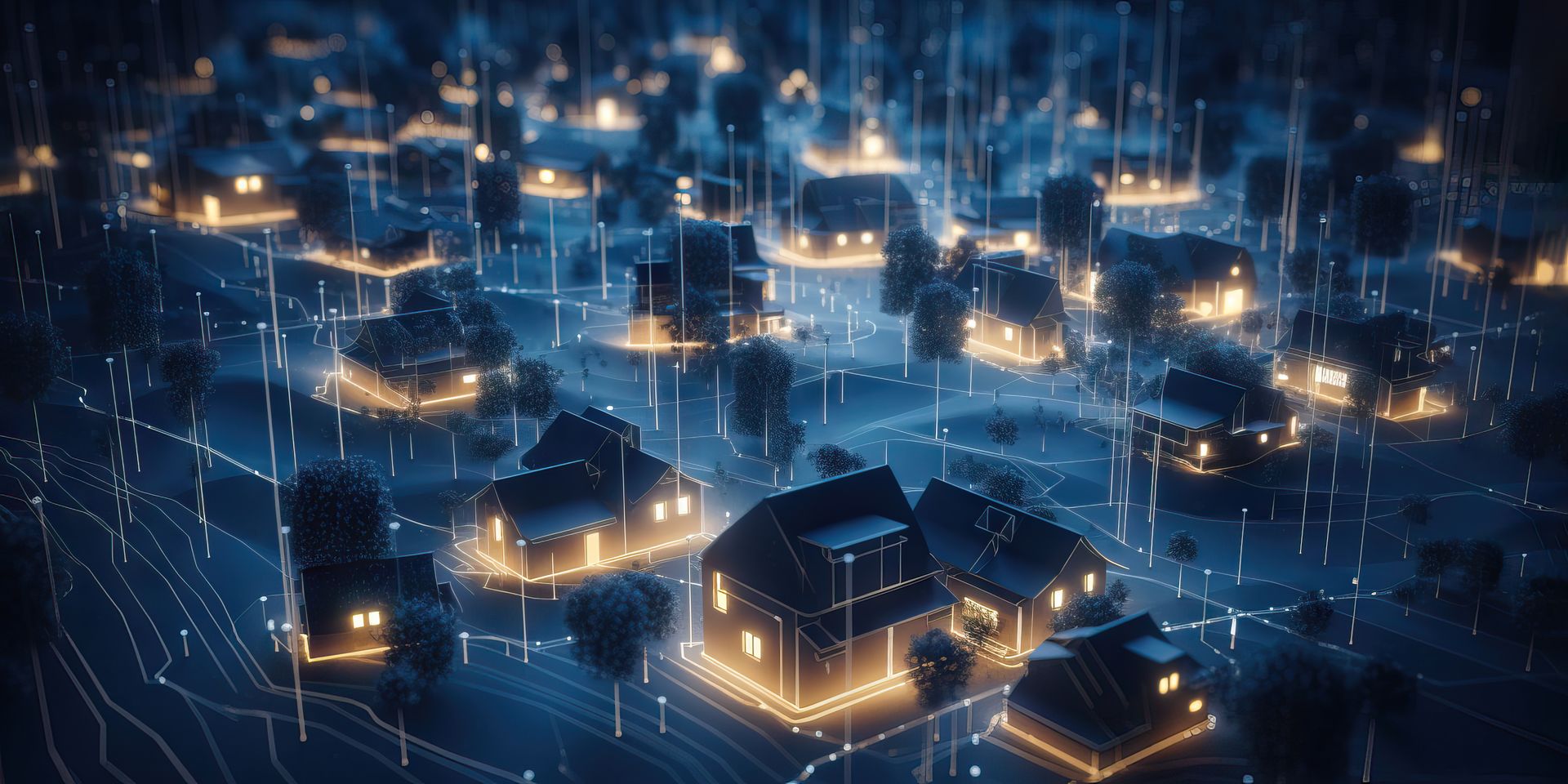Virtual Power Plants (VPPs) are becoming increasingly popular in the Australian energy market as a way for homeowners to not only save on their electricity bills but also contribute to a more sustainable future.
However, as attractive as this concept may seem, homeowners need to understand the potential drawbacks before jumping on the VPP bandwagon. In this blog post, we will explore whether joining a VPP is truly the best option for achieving energy independence for your home.
Spoiler alert: the answer may surprise you.

What is a Virtual Power Plant (VPP)
A Virtual Power Plant (VPP) is a revolutionary concept that allows homeowners to connect their solar battery systems and collectively generate and store energy. It operates on the principle of energy sharing, where excess energy generated by solar panels is stored in the homeowner's solar battery, and this stored energy is distributed onto the network. Control is handed over to the VPP provider, who determines when your battery discharges.
Essentially, a VPP transforms a cluster of individual homes into a community power plant.
At the heart of a VPP are solar batteries, like the popular Tesla Powerwall or SolarEdge Home Battery, which are installed in each participating home. The majority of solar battery owners install a battery to provide their home backup power and continue to offset their energy usage with solar even after the sun has set.

Credit: Tesla Energy Plan
You can join a VPP any time you like, whether it be immediately after installation or a few months after. When a battery owner joins a VPP program, their batteries are connected to a central management system, allowing the aggregated energy from all participants to be dispatched to the grid when demand is high or to be consumed within the community during peak usage periods. By optimising the use of stored energy, VPPs aim to create a stable grid that relies less on traditional fossil fuel power sources.
For Australian households, VPPs may appear to be an attractive option from the outset. With promises of reduced electricity bills and the ability to earn credits and rewards on their bills, some homeowners think the savings generated from an incentivised VPP program will improve their return on investment. However, it's essential to consider the challenges that come with participating in a VPP program.
These challenges are generally a result of a conflict between why the homeowner installed a battery in the first place and how joining a VPP disrupts that.
Why do people get solar batteries?
We recently surveyed Springers Solar battery customers to find out why they decided to invest in a solar battery.
The overwhelming majority gave two simple reasons: to save more money on their electricity bills and to distance themselves further from electricity retailers.
While solar batteries are still a substantial investment, the allure lies in liberation from traditional electricity providers who continue to increase electricity prices. Opting for solar self-consumption becomes an attractive alternative, diminishing reliance on the grid during nighttime and resulting in considerable savings. This shift not only reduces grid reliance but also preserves funds that would otherwise be allocated to cover the costs of overnight conventional energy consumption.
So, to put plainly, Australian households are buying batteries to benefit themselves and their own home. Valuing your own savings and personal benefit is a perfectly good reason to purchase a battery.
With this in mind, VPP programs don't really align with this value proposition. VPPs ask battery owners to share the energy they generate from their solar panels and store in their battery with the broader community. Often, this power is shared during peak periods, at times when you would want to use the battery yourself.
So, if you're considering joining a VPP program, you should ask yourself:
- What do you value?
- What are you willing to sacrifice?
The challenges of VPPs for Australian households
One of the main challenges of participating in a VPP is the impact on return on investment (ROI). Whilst VPPs may offer electricity bill credits, joining a VPP is highly likely to extend the payback period of your solar battery system, rather than shorten it.
This means that it would take longer for homeowners to recoup their initial investment and start realising actual savings back in pocket.
Your payback period is heavily influenced by how much solar energy you consume in your home. Basically, the more solar energy you use (during the day and at night), the faster the system will pay itself off. Once your system has paid itself off, the savings you generate is cash back in your pocket that would have otherwise been spent on electricity bills.
If you export the energy you generate to a VPP, you are reducing the amount of solar energy that you can personally use because you are sharing it with the community to stabilise the grid and to give profits to the VPP provider. Thereby, you are losing out on precious solar self-consumption time.
Improving your solar self-consumption promises superior returns, as utilising the energy generated directly from your solar panels significantly reduces your bills. This approach outshines the benefits derived from a VPP credit and even the returns from a feed-in tariff. In fact, self-consumption is worth roughly double your feed-in tariff, meaning that using up as much of your solar as possible is the key to maximising your solar savings.
Another challenge is the lack of control over the use of stored solar energy. Participating in a VPP often requires homeowners to surrender control over when and how they use their stored energy. This limitation can be problematic for those seeking to maximise self-consumption and minimise reliance on the grid.
For example, if your agreement with your VPP states that they can discharge up to 200kWh of energy from your battery every year, you don't get to control when this occurs. This can be particularly problematic if you experience a blackout but can't use your battery's backup power, as the VPP has already discharged your battery. Bummer, right?
Another downside to joining a VPP is that often, you will be locked into a long-term contract with the VPP provider.
But on the flip side, you are contributing to a more stable grid and will receive some credits on your next bill to compensate.
It is important to consider whether giving up control over your energy usage aligns with your goals and priorities and assess the potential savings from a VPP against the control you will be relinquishing.
In a nutshell, joining a VPP can compromise your:
- Return on investment
- Payback period
- Solar self-consumption
- Your independence from the grid
But you are contributing to:
- A stabilised grid for your community
- A saving on your next electricity bill
Alternatives to achieving energy independence
While VPPs may seem like an enticing compromise between energy independence and added electricity bill savings, there are alternative solutions that could offer more benefits for Aussie households. Ultimately, what you should be looking for is a way to better control your energy usage and maximise your return on investment.
As discussed above, you can simply purchase a battery without participating in a VPP program. By choosing a battery storage system tailored to your specific needs, you can maintain full control over your stored energy and use it as you see fit. This allows you to maximise solar self-consumption and reduce reliance on the grid without having to surrender control to a VPP program.
Using your stored energy at night will permit you to significantly reduce your reliance on the grid and save money that would have otherwise been spent on powering your home overnight. A battery can also offer backup protection, meaning that you can keep your lights and essential appliances running even during a grid outage.
Additionally, investing in a battery storage system for personal use can offer a faster payback period, as you won't be sharing your stored energy with other participants in a VPP.
Another alternative is installing a larger solar panel system. By increasing the size of your solar panel system, you can generate more electricity and increase self-consumption. This means that you'll rely less on the grid for your energy needs, resulting in lower electricity bills and a greater sense of energy independence. While this alternative may require a higher upfront investment, the long-term savings and control over your energy usage can make it a worthwhile option.
Also, investing in an oversized solar system guarantees that future energy user add-ons can also be supplied by solar. If you plan on installing additional air conditioning units, a pool, EV chargers, or other large energy consumers, we always recommend oversizing your system to avoid expensive retrofitting costs down the track.
Our verdict: Be selfish with your energy
We are advocates for serving your family's energy needs first. If you choose to invest in home battery storage, you should focus on generating, storing, and using as much solar energy as possible in your home, as this is what will guarantee a healthy return on investment and a shortened payback period.
Ultimately, the decision to join a VPP program or pursue alternative solutions for energy independence should be based on your specific goals, priorities, and budget. While VPPs may offer some benefits, such as electricity bill credits, they also come with heavy caveats and challenges that would impact your personal use of the battery.
It's important to carefully evaluate all options and choose the path that aligns with your objectives and provides the greatest value for your investment.


What is a VPP?